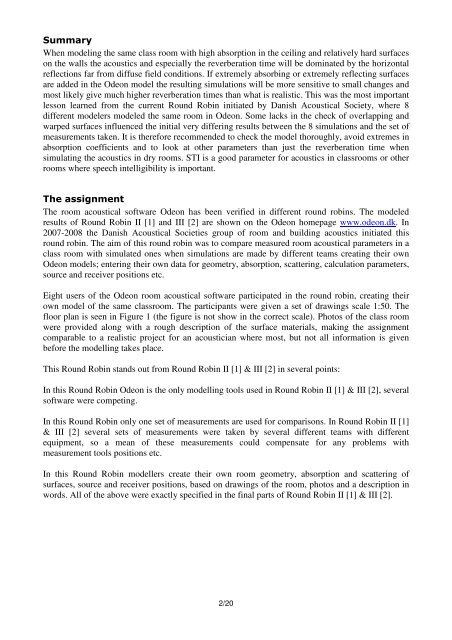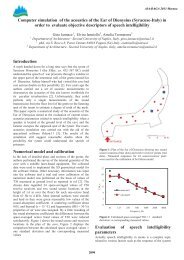Danish Acoustical Society Round Robin on room acoustic computer ...
Danish Acoustical Society Round Robin on room acoustic computer ...
Danish Acoustical Society Round Robin on room acoustic computer ...
Create successful ePaper yourself
Turn your PDF publications into a flip-book with our unique Google optimized e-Paper software.
Summary<br />
When modeling the same class <strong>room</strong> with high absorpti<strong>on</strong> in the ceiling and relatively hard surfaces<br />
<strong>on</strong> the walls the <strong>acoustic</strong>s and especially the reverberati<strong>on</strong> time will be dominated by the horiz<strong>on</strong>tal<br />
reflecti<strong>on</strong>s far from diffuse field c<strong>on</strong>diti<strong>on</strong>s. If extremely absorbing or extremely reflecting surfaces<br />
are added in the Ode<strong>on</strong> model the resulting simulati<strong>on</strong>s will be more sensitive to small changes and<br />
most likely give much higher reverberati<strong>on</strong> times than what is realistic. This was the most important<br />
less<strong>on</strong> learned from the current <str<strong>on</strong>g>Round</str<strong>on</strong>g> <str<strong>on</strong>g>Robin</str<strong>on</strong>g> initiated by <str<strong>on</strong>g>Danish</str<strong>on</strong>g> <str<strong>on</strong>g>Acoustical</str<strong>on</strong>g> <str<strong>on</strong>g>Society</str<strong>on</strong>g>, where 8<br />
different modelers modeled the same <strong>room</strong> in Ode<strong>on</strong>. Some lacks in the check of overlapping and<br />
warped surfaces influenced the initial very differing results between the 8 simulati<strong>on</strong>s and the set of<br />
measurements taken. It is therefore recommended to check the model thoroughly, avoid extremes in<br />
absorpti<strong>on</strong> coefficients and to look at other parameters than just the reverberati<strong>on</strong> time when<br />
simulating the <strong>acoustic</strong>s in dry <strong>room</strong>s. STI is a good parameter for <strong>acoustic</strong>s in class<strong>room</strong>s or other<br />
<strong>room</strong>s where speech intelligibility is important.<br />
The assignment<br />
The <strong>room</strong> <strong>acoustic</strong>al software Ode<strong>on</strong> has been verified in different round robins. The modeled<br />
results of <str<strong>on</strong>g>Round</str<strong>on</strong>g> <str<strong>on</strong>g>Robin</str<strong>on</strong>g> II [1] and III [2] are shown <strong>on</strong> the Ode<strong>on</strong> homepage www.ode<strong>on</strong>.dk. In<br />
2007-2008 the <str<strong>on</strong>g>Danish</str<strong>on</strong>g> <str<strong>on</strong>g>Acoustical</str<strong>on</strong>g> Societies group of <strong>room</strong> and building <strong>acoustic</strong>s initiated this<br />
round robin. The aim of this round robin was to compare measured <strong>room</strong> <strong>acoustic</strong>al parameters in a<br />
class <strong>room</strong> with simulated <strong>on</strong>es when simulati<strong>on</strong>s are made by different teams creating their own<br />
Ode<strong>on</strong> models; entering their own data for geometry, absorpti<strong>on</strong>, scattering, calculati<strong>on</strong> parameters,<br />
source and receiver positi<strong>on</strong>s etc.<br />
Eight users of the Ode<strong>on</strong> <strong>room</strong> <strong>acoustic</strong>al software participated in the round robin, creating their<br />
own model of the same class<strong>room</strong>. The participants were given a set of drawings scale 1:50. The<br />
floor plan is seen in Figure 1 (the figure is not show in the correct scale). Photos of the class <strong>room</strong><br />
were provided al<strong>on</strong>g with a rough descripti<strong>on</strong> of the surface materials, making the assignment<br />
comparable to a realistic project for an <strong>acoustic</strong>ian where most, but not all informati<strong>on</strong> is given<br />
before the modelling takes place.<br />
This <str<strong>on</strong>g>Round</str<strong>on</strong>g> <str<strong>on</strong>g>Robin</str<strong>on</strong>g> stands out from <str<strong>on</strong>g>Round</str<strong>on</strong>g> <str<strong>on</strong>g>Robin</str<strong>on</strong>g> II [1] & III [2] in several points:<br />
In this <str<strong>on</strong>g>Round</str<strong>on</strong>g> <str<strong>on</strong>g>Robin</str<strong>on</strong>g> Ode<strong>on</strong> is the <strong>on</strong>ly modelling tools used in <str<strong>on</strong>g>Round</str<strong>on</strong>g> <str<strong>on</strong>g>Robin</str<strong>on</strong>g> II [1] & III [2], several<br />
software were competing.<br />
In this <str<strong>on</strong>g>Round</str<strong>on</strong>g> <str<strong>on</strong>g>Robin</str<strong>on</strong>g> <strong>on</strong>ly <strong>on</strong>e set of measurements are used for comparis<strong>on</strong>s. In <str<strong>on</strong>g>Round</str<strong>on</strong>g> <str<strong>on</strong>g>Robin</str<strong>on</strong>g> II [1]<br />
& III [2] several sets of measurements were taken by several different teams with different<br />
equipment, so a mean of these measurements could compensate for any problems with<br />
measurement tools positi<strong>on</strong>s etc.<br />
In this <str<strong>on</strong>g>Round</str<strong>on</strong>g> <str<strong>on</strong>g>Robin</str<strong>on</strong>g> modellers create their own <strong>room</strong> geometry, absorpti<strong>on</strong> and scattering of<br />
surfaces, source and receiver positi<strong>on</strong>s, based <strong>on</strong> drawings of the <strong>room</strong>, photos and a descripti<strong>on</strong> in<br />
words. All of the above were exactly specified in the final parts of <str<strong>on</strong>g>Round</str<strong>on</strong>g> <str<strong>on</strong>g>Robin</str<strong>on</strong>g> II [1] & III [2].<br />
2/20

















